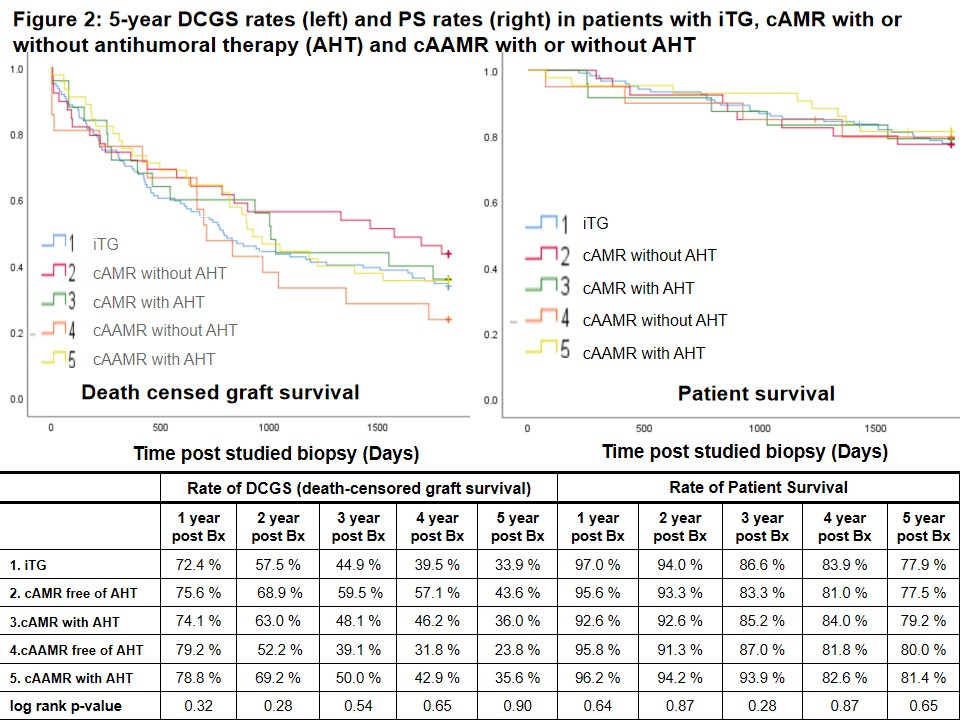Poor Outcomes in Patients with Transplant Glomerulopathy Independent of Banff Categorization or Therapeutic Interventions
1Department of Nephrology, Charite Campus Mitte, Berlin, Germany, 2Institut für Transfusionsmedizin, Charite Virchow Klinikum, Berlin, Germany, 3Institut für Pathologie, Charite Campus Mitte, Berlin, Germany
Meeting: 2022 American Transplant Congress
Abstract number: 1411
Keywords: Biopsy, Graft survival, HLA antibodies, Kidney transplantation
Topic: Clinical Science » Kidney » 45 - Kidney Chronic Antibody Mediated Rejection
Session Information
Session Name: Kidney Chronic Antibody Mediated Rejection
Session Type: Poster Abstract
Date: Monday, June 6, 2022
Session Time: 7:00pm-8:00pm
 Presentation Time: 7:00pm-8:00pm
Presentation Time: 7:00pm-8:00pm
Location: Hynes Halls C & D
*Purpose: Banff classification is an accepted diagnostic tool, but also used as a tool to define endpoints in clinical trials. There is a need to investigate whether transplant glomerulopathy (TG) is suited as a robust surrogate endpoint to predict long-term graft outcomes.
*Methods: According to the Banff’17 criteria, the first biopsy-proven TG of 282 kidney allograft recipients with complete follow-up was investigated and patients were divided into three groups: chronic antibody-mediated rejection (cAMR, n=72), chronic active antibody-mediated rejection (cAAMR, n=76), and isolated transplant glomerulopathy (iTG, n=134). In addition, 25 cAMR and 46 cAAMR patients received antihumoral therapy (AHT) primarily consisting of high-dose intravenous immunoglobulin and plasmapheresis.
*Results: There were no significant differences in clinical characteristics, allograft function, and clinical outcomes among three TG groups (figure 1). Interestingly, cAMR and cAAMR patients receiving AHT had comparable 5-year death-censored graft survival (DCGS) rates compared to patients without AHT, and similar in comparison to patients with iTG (figure 2). The Banff TG score was not associated with DCGS (Table 1); the Cox-regression analysis demonstrated that Banff mm-, ci- and ct-lesions were closely associated with graft failure at 5-year post studied biopsy.
*Conclusions: The occurrence of TG is associated with poor long-term outcomes independent of the Banff categorization or score or AHT. The Banff lesion scores indicating chronic allograft scarring might be better suited to predict an unfavorable outcome.
| iTG
% (patients number)
|
cAMR
% (patients number)
|
cAAMR% (patients number) | Overall
% (patients number)
|
|
| cg1 | 44.4% (n=36) | 37.5% (n=16) | 28.6% (n=7) | 40.7% (n=59) |
| cg2 | 23.6% (n=55) | 39.1% (n=23) | 52.6% (n=19) | 33.0% (n=97) |
| cg3 | 39.4% (n=40) | 44.0% (n=25) | 22.5% (n=40) | 33.7 (n=98) |
| Log rank p-value | 0.50 | 0.84 | 0.34 | 0.45 |
To cite this abstract in AMA style:
Wu K, Schmidt D, Moral CLopezdel, Zhang Q, Halleck F, Naik MG, Lachmann N, Rudolph B, Budde K. Poor Outcomes in Patients with Transplant Glomerulopathy Independent of Banff Categorization or Therapeutic Interventions [abstract]. Am J Transplant. 2022; 22 (suppl 3). https://atcmeetingabstracts.com/abstract/poor-outcomes-in-patients-with-transplant-glomerulopathy-independent-of-banff-categorization-or-therapeutic-interventions/. Accessed January 1, 2026.« Back to 2022 American Transplant Congress


